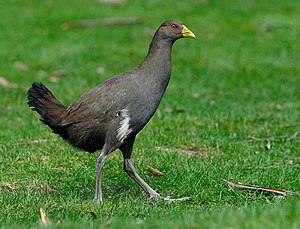Tasmanian grouse
| Tasmanian grouse | ||||||||||
|---|---|---|---|---|---|---|---|---|---|---|

Tasmanian grouse ( Gallinula mortierii ) |
||||||||||
| Systematics | ||||||||||
|
||||||||||
| Scientific name | ||||||||||
| Gallinula mortierii | ||||||||||
| ( Du Bus de Gisignies , 1840) |
As Tasmanian Nativehen or Grünfußpfuhlhuhn ( Gallinula mortierii ) one is flying incapable Moorhen referred that in Tasmania lives including some surrounding islands.
Nutrition and habitats
Tasmanian grouse weigh about 400 g. They mainly feed on leaves and seeds. They colonize different habitats such as open fields and pastures, freshwater wetlands. It needs meadows with short grass for foraging and is now dependent on areas grazed by introduced species such as sheep, cattle and rabbits. In the past, suitable habitats were created by fire and grazing marsupials.
Threat status
They are unable to fly, which makes them vulnerable to imported predators. Nevertheless, the species is still very abundant and is considered an agricultural pest. The global habitat covers 20,000 to 50,000 km²; the Tasmanian grouse is not yet considered endangered. The introduced foxes are potentially a threat to the species, even if they are still rare now (2007).
They originally also existed on the mainland in Australia, but they became extinct about 4,700 years ago around the time the dingo immigrated to Australia. Since then, the animal has only existed on Tasmania and offshore islands.
Young rearing and territorial behavior
Green-footed hens often look after a nest in groups. There are both simple pairs and groups with several fertile males, as well as groups where several females lay eggs. The clutch size depends on the number of females, as they all lay their eggs in the same nest. The size of the group varies between two and 13 adults. In animals that breed together, animals of the same sex are mostly related to one another.
The contribution of individual animals to the clutch is very different. Young animals of the last two years often help raise the young without contributing to the clutch.
When food is abundant, green-footed grouse lay not only five eggs once a year, as is the case on average, but nine to ten eggs twice a year. They have many enemies such as marsupial devils , ravens, harriers and eagles. The breeding success therefore depends heavily on the distance between the meadow for foraging and the thicket as a hiding place.
The same group occupies their breeding territory for several years. Animals in particularly good breeding sites are so successful in rearing their young that their offspring gradually occupy additional neighboring territories.
swell
- Anne W. Goldizen, David A. Putland, Alan R. Goldizen: Variable Mating Patterns in Tasmanian Native Hens (Gallinula mortierii): Correlates of Reproductive Success. In: The Journal of Animal Ecology. Vol. 67, No. 2, Mar 1998, pp. 307-317.
- AW Goldizen, JC Buchan, DA Putland, AR Goldizen, EA Krebs: Patterns of mate-sharing in a population of Tasmanian Native Hens Gallinula mortierii. In: Ibis. Vol. 142, no. 1, Jan 2000, pp. 40-47.
- David A. Putland, Anne W. Goldizen: Family dynasties in the Tasmanian native hen. Behavioral Ecology and Sociobiology. Volume 51, Number 1, December 2001. (springerlink.com)
- Anne W. Goldizen, David A. Putland, Kelly A. Robertson: Dispersal strategies in Tasmanian native hens (Gallinula mortierii). In: Behavioral Ecology. Vol. 13, No. 3, pp. 328-336. (beheco.oxfordjournals.org)
- BirdLife International 2004. Gallinula mortierii. In: IUCN 2006. 2006 IUCN Red List of Threatened Species. www.iucnredlist.org. Retrieved September 9, 2007.
Web links
- Tribonyx mortierii inthe IUCN 2013 Red List of Threatened Species . Listed by: BirdLife International, 2012. Retrieved February 2, 2014.

